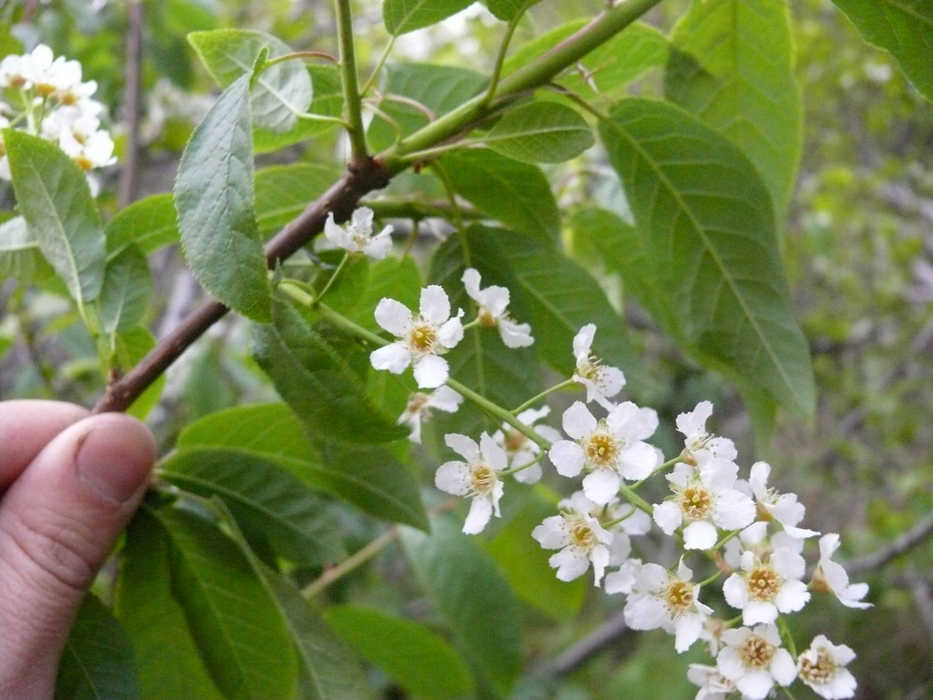Earlier this summer as I walked the beach north of the Kasilof River mouth, I did a double-take as I passed a shrub that seemed out of place in this lush wetland adjoining the beach. It was a mayday tree, a.k.a. Prunus padus or European bird cherry. A little poking around yielded more cherry trees peppered throughout the wetland including larger individuals in full blossom.
This was a preview of what may be in store for stream corridors and moist woods on the Kenai Peninsula. European bird cherries have already spread extensively along streams in the Anchorage area, outcompeting native willows and alders to become the dominant species lining many stream stretches, in some places forming pure stands of cherries. Infestations have also been found in Fairbanks and in southeast Alaska. On the Kenai Peninsula, bird cherries are just starting to escape into the surrounding wilds in Hope, Homer, and Kasilof.
European bird cherries are popular landscape trees in Alaska for good reasons. They grow quite well in our climate and in our gardens because moose generally do not eat these trees. In spring they produce abundant showy, fragrant blossoms. In late summer the fruits are highly attractive to birds.
Many species of birds partake of the fruits, giving the bird cherry its name. In exchange for feeding the birds, the trees receive a seed dispersal service. Robins, for example, swallow the small cherries whole, then usually flit to a nearby protected perch to regurgitate the cherry stones.
Moose prefer other shrubs, but they will resort to eating cherries in hard winters when other food plants become scarce. Unfortunately for moose, European bird cherry foliage contains cyanogenic glycosides, which has led to the deaths of several moose in Anchorage by cyanide poisoning in recent years. On a larger scale, a bigger concern for moose is that invasive cherries have the potential to outcompete and replace their preferred willows, at least along streams.
The effects of bird cherries on salmon and salmon stream food webs are not yet clear, but the cherries do not appear to benefit salmon. A study in Anchorage streams found that European bird cherries supported a lower biomass of insects than native trees and shrubs, suggesting that they may provide less potential food for salmon fry than native vegetation. Replacement of nitrogen-fixing alders by cherries could also lead to lower overall stream productivity.
Historically, people have harvested the small, astringent fruits of Prunus padus for eating fresh and for preserves, but it appears that people generally prefer to use other fruits over bird cherries. I failed to find any recipe using bird cherries.
Expect to hear more about this species in the future. While Prunus padus has not yet made the Alaska Department of Natural Resources’ list of Prohibited & Restricted Noxious Weeds or the UAF Cooperative Extension Service’s DON’T Plant in Alaska list, it received a high invasiveness ranking (74/100) from the Alaska Natural Heritage Program. An article from the Alaska Department of Fish and Game’s website stated that the Alaska Department of Natural Resources was moving to list Prunus padus as a prohibited plant.
In the Anchorage area, systematic removal of bird cherry is well underway by mechanical and chemical means. This June marked the Kenai Peninsula’s first effort at removing bird cherries when a group from the American Hiking Society spent a day pulling bird cherries around the Hope Museum.
We are close to the decision point regarding whether or not bird cherries should be allowed to become a permanent part of our streamside plant communities on the Kenai Peninsula. We are presently within the time window when it is still realistic to eradicate and exclude bird cherries from the Kenai with relatively little cost.
It may yet be possible to exclude bird cherries from our flora because birds generally do not carry cherry seeds far. This is in contrast to wind-dispersed weeds like dandelions, where their introduction is essentially irrevocable once they have become established.
Once bird cherries have dispersed up our stream corridors into less accessible areas, it is reasonable to expect that bird cherries will permanently become a substantial and ubiquitous part of our streamside communities, making the Kenai a little more like Europe, a little less like Alaska, and perhaps a little less special.
Matt Bowser serves as Entomologist at the Kenai National Wildlife Refuge. You can find more information at www.fws.gov/refuge/kenai/ or www.facebook.com/kenainationalwildliferefuge.

